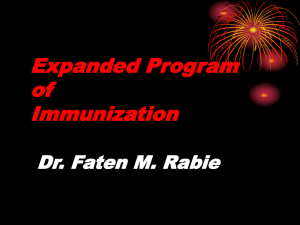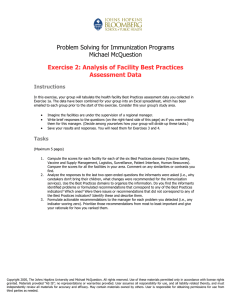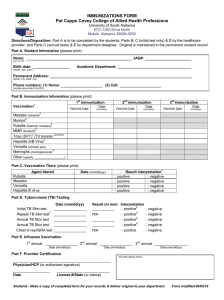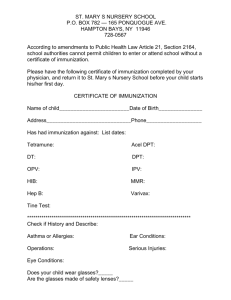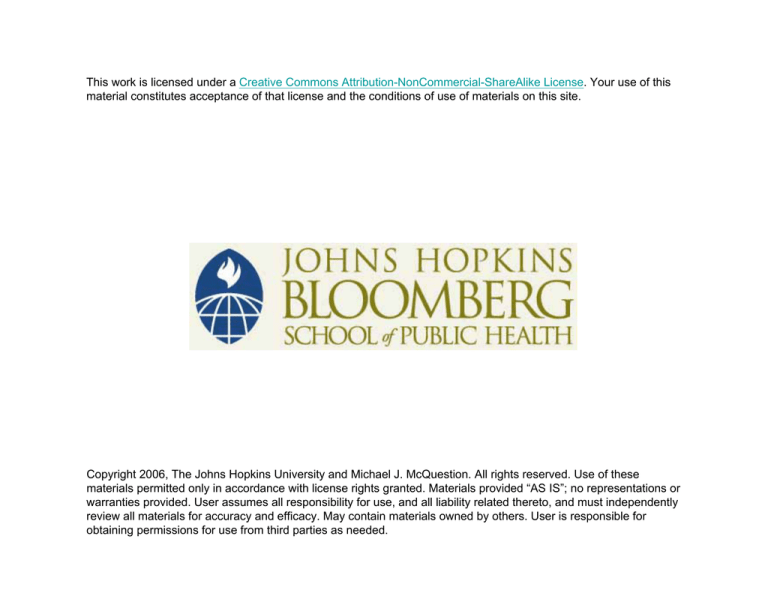
This work is licensed under a Creative Commons Attribution-NonCommercial-ShareAlike License. Your use of this
material constitutes acceptance of that license and the conditions of use of materials on this site.
Copyright 2006, The Johns Hopkins University and Michael J. McQuestion. All rights reserved. Use of these
materials permitted only in accordance with license rights granted. Materials provided “AS IS”; no representations or
warranties provided. User assumes all responsibility for use, and all liability related thereto, and must independently
review all materials for accuracy and efficacy. May contain materials owned by others. User is responsible for
obtaining permissions for use from third parties as needed.
Measurement Concepts and
Introduction to Problem Solving
Michael J. McQuestion, PhD, MPH
Johns Hopkins University
Objectives
After listening to, viewing, and studying the lecture
materials in this course, you will be able to do the
following:
− Describe sources of vaccine coverage, target
disease, and cost data
− Explain and apply standard immunization
program measurement concepts
− Distinguish alternative theories and
methodological approaches to problem solving
2
Section A
Immunization Program Data: Disease
Incidence, Vaccine Coverage, Program Costs
Main Sources of EPI Target Disease Data
4
Hallmarks of the U.S. Disease-Reporting System
Decentralized, comprehensive
Redundant state and federal capabilities
Fax and online reporting
Prompt outbreak investigation, feedback (MMWR)
5
Excerpt of CA Measles-Reporting Form
6
Hallmarks of Global Disease Reporting System
Historically incomplete, delayed in many countries
Exceptions: smallpox, polio, measles (active
surveillance + outbreak investigation)
Steady improvements in recent years
7
WHO Vaccine-Preventable Diseases Monitoring System
Includes the following indicators
− Coverage rate time series by vaccine
− Annual numbers of cases EPI target diseases
− Proportion of districts reporting
− DPT3 dropout rates
http://www.who.int/vaccines-surveillance/intro.html
8
Global Surveillance Systems
9
Main Sources of Vaccine Coverage Data
United States
− National Immunization Survey: 1994–present
− National Health and Nutrition Examination
Survey (NHANES): 1960–present
− State registries
Developing world
− World fertility surveys (1972–84, 60 LDCs)
− Demographic and health surveys (1984–
present, ~200 done so far in over 70 countries)
− Ministries of health, UN statistics
10
United States National Immunization Survey
Surveys 78 Immunization Action Plan areas
Produces annualized coverage estimates for 10
antigens
Identifies particular high-risk groups
Telephone survey + provider record check
Santoli et al (1999) used 1997 NIS to estimate
proportion of vaccinations given through Vaccines
for Children Program
Using 1999 NIS data, Luman et al (2001) showed
that 75% of incompletely immunized children were
only one visit away from completing their
immunization schedules
11
Sources of Immunization-Cost Data
Administrative record reviews
Vaccine manufacturers
Living Standards Measurement Surveys (World
Bank, selected LDCs)
Other surveys
12
Immunization Costs
United States
− Lieu et al (2000) computed the costs of
streptococcus pneumonia in a cohort of U.S.
children
− Result: routine immunization against the
disease would save $760m/year
Developing world
− San Sebastian et al (2001) compared hospitalbased to community health worker-based
delivery strategies in one region of Ecuador
− Result: CHWs immunized children more
cheaply than hospitals
13
Two Key Macro EPI Measures
Equity: does the program reach all groups?
Sustainability: can high performance be
maintained?
14
Equity and Sustainability: Three Latin American Countries
Percent Children Ages 12–23m Fully
Immunized, DHS Surveys
urban
rural
B
B
ol
iv
ia
ol 19
8
iv
ia 9
B
ol 19
9
iv
ia 4
1
B
ra 99
8
B
z
ra il 1
zi
l 1 986
9
B 91
C raz (1)
ol
i
o m l 19
b i 96
C
ol
a
o m 19
b i 86
C
ol
a
o m 19
b i 90
C
ol
a
o m 19
b i 95
a
20
00
90
80
70
60
50
40
30
20
10
0
15
Equity and Sustainability: Three African Countries
Percent of Children 12–23m Fully
Immunized, DHS Surveys
90
80
70
60
50
40
30
20
10
0
d'
99
Iv
ot
oi
e
re
d'
19
Iv
oi
94
re
19
98
/9
K
9
en
ya
19
89
K
en
ya
19
93
K
en
ya
19
98
19
98
/
C
C
ot
e
Fa
so
ur
ki
na
B
B
ur
ki
na
Fa
so
19
92
/
93
urban
rural
16
Some Key Micro-Level Measures
Efficiency, affordability, cost-effectiveness
Access (cost, convenience)
Community demand
Quality of services
17
Generating Local Immunization Data
Surveys can retrieve data from three sources
− Vaccination cards
− Parental recall
− Medical and administrative records
The veracity of the data varies by context
18
Local Data
United States
− Bolton et al (1998) compared vaccination card,
parental recall, and medical records data for a
cohort of 525 Baltimore children
− Results: parents overestimated and the cards
underestimated immunization status
Developing world
− Onta et al (1998) studied administrative EPI
data from Nepal
− Results: district health offices, peripheral health
workers routinely inflate vaccination reports
Continued
19
Local Data
Later in the course, we will learn more about
several methods to generate local data, including:
− Cluster sample surveys
− Lot quality assurance
− Provider databases (CASA Program)
20
Section B
A Problem-Solving Paradigm
Problem Solving “Paradigm:”
This is but one approach; use what works for you!
− Define problem
− Measure its magnitude
− Conceptualize its determinants
− Strategize interventions
− Implement and evaluate
22
First Step in Problem-Solving: Define the Problem
Someone identifies a problem and calls for a
solution
Who selects it and how it is chosen affect both the
intervention and its resources
Why the concern arises and how the problem is
defined frame the choice of strategy
23
Vaccination
“…an expression of trust between patient and
provider [that is] strongly shaped by the
management practices of [health care]
organizations” (Gilson, in press)
Continued
24
Vaccination
“…an expression of trust between patient and
provider [that is] strongly shaped by the
management practices of [health care]
organizations” (Gilson, in press)
“A health input parents choose conditional on their
resources and competing wants” (Victor Fuchs,
1996)
Continued
25
Vaccination
“…an expression of trust between patient and
provider [that is] strongly shaped by the
management practices of [health care]
organizations” (Gilson, in press)
“A health input parents choose conditional on their
resources and competing wants” (Victor Fuchs,
1996)
“Basic health services, including essential
immunization, are a human right” (WHO 2001)
Continued
26
Vaccination
Which statement is correct?
All of them, for different reasons
There are many ways to frame a problem
27
Alternative Problem Frames
Our children are unimmunized because:
− Funding has been cut (political)
− Parents don’t care (moral)
− Health workers don’t do their job
(organizational)
− Disease risk is minimal (epidemiologic)
28
The Frame Sets the Parameters for the Solution
Management frame
− Problem: low
immunization
utilization
− Solution: improve
quality of services
29
Alternative Frames
Economistic frame
− Problem: parents not willing to pay
− Solution: reduce vaccination costs
Continued
30
Alternative Frames
Sociological frame
− Problem: vaccine coverage low in some
communities
− Solution: mobilize target communities
31
Problem Definition
Few problems can be conceptualized in purely
logical, factual terms
Problem definition always entails practical valuejudgments
Each frame strives to be logical but invariably
imposes its particular parameters (theoretical
boundaries) and value judgments
Continued
32
Problem Definition
The fact that immunizing children is problematized
across disciplines and cultures points to an
underlying value judgment that it is important
Given the above, a robust problem-solving
approach should be:
− Reflexive, making value judgments explicit
− Evidence-based
In this course, we will use materials drawn from
three frames of reference:
− Epidemiological
− Economistic
− Sociological
33
Epidemiological Concepts
Individual
Exposure
Case
Risk factors
Participation
Population
Endemicity
Prevalence, incidence
Contextual factors
Coverage
34
Step Two: Measure the Magnitude of the Problem
Defining problems using different frames
− Taps different dimensions
− Reveals different measurement approaches
− Can lead to more robust solutions
35
Epidemiologic EPI Measures
No. cases EPI target disease x
No. inhabitants
% communities with ≥ 80% children
12–23m fully immunized
No. households with child 12–23m fully immunized
No. households with child age 12–23m
% health facilities reporting AFP cases weekly
36
Economic Concepts
Rationality
Heterogeneous preferences
Marginal utility
Substitutability
Markets: supply-demand equilibria
37
Economic EPI Measures
Efficiency
− $/child vaccinated
Cost-effectiveness
$/child 12–23m fully immunized, strategy 1
$/child 12–23m fully immunized, strategy 2
Viability
− $ collected/$ spent on EPI
Continued
38
Economic EPI Measures
Equity
% lowest income quartile fully immunized
% highest income quartile fully immunized
Cost-benefit
$/immunization against disease x
$/case EPI target disease x
39
Sociological Concepts
Individual
Attributes: Ascribed,
attained
Beliefs: Self-efficacy,
Perceived vulnerability
Behaviors
Reference groups,
social networks
Group-level
Social structure: strata,
heterogeneity,
inequality
Institutions, norms
Collective action
Communities
40
Sociological EPI Measures
% communities with local health committees
meeting at least quarterly
Whether local health committee controls local
health resources
No. volunteer-days contributed for local vaccination
activities
No. consecutive years community has ≥ 80%
children 12–23 months fully immunized
41
Note That Some Concepts Are Operationalized Differently
Example: sustainability
− Epidemiologic: program maintains high
coverage
− Economic: program is self-financing
− Sociological: community reproduces
vaccination behaviors, norms
42
Low-Income Countries and Routine Vaccines: Financing
43
Step Three: Conceptualize Problem Determinants
Once framed, a problem is analyzed to identify and
conceptualize its determinants
This process necessarily entails two steps:
− Theorizing
− Making causal inferences
44
Definition
Theory — “A particular set of propositions,
postulates and assumptions devised to explain
some set of facts or phenomena”
45
Examples of Relevant Theories
Epidemiology
− Germ theory
− Epidemic models
Economics
− Free market/ consumer choice
− Human capital model
Sociology
− Symbolic interactionism
− Organizational behavior
− Collective action
46
Theories
A range of theories can be invoked to solve
vaccination program problems, and they generally
do not overlap
What the theories do have in common is the notion
of causality
− For every problem (effect) there must be a
cause (which hopefully can be mitigated)
47
Four Conditions for Causal Inference
1.
2.
3.
4.
Association: cause, effect (X,Y) are correlated
Time order: cause X must precede effect Y
Nonspuriousness: X, not Z, is the true cause
Mechanism: X theoretically linked to Y
48
Causal Inference
In practice, identifying a particular cause of
immunization program problems is difficult
− The problems have multiple causes
− Many causes are unobservable
As a result, most empirical research fails to meet
all causal inference criteria
The methodologically strongest are experiments or
quasi-experiments that randomize subjects and
compare the outcomes of treatment, control groups
Problem: most programs are full-coverage, so
exposure cannot be controlled
49
Next Lecture
In the next lecture, we will learn more about how
problem-solving interventions are designed,
implemented, and evaluated
50
Summary
Continued
51
Summary
High-quality immunization data are increasingly
accessible
Immunization problems can be framed and
measured from several disciplinary perspectives
Theories rarely overlap and causal inferences are
rare in problem solving
52

